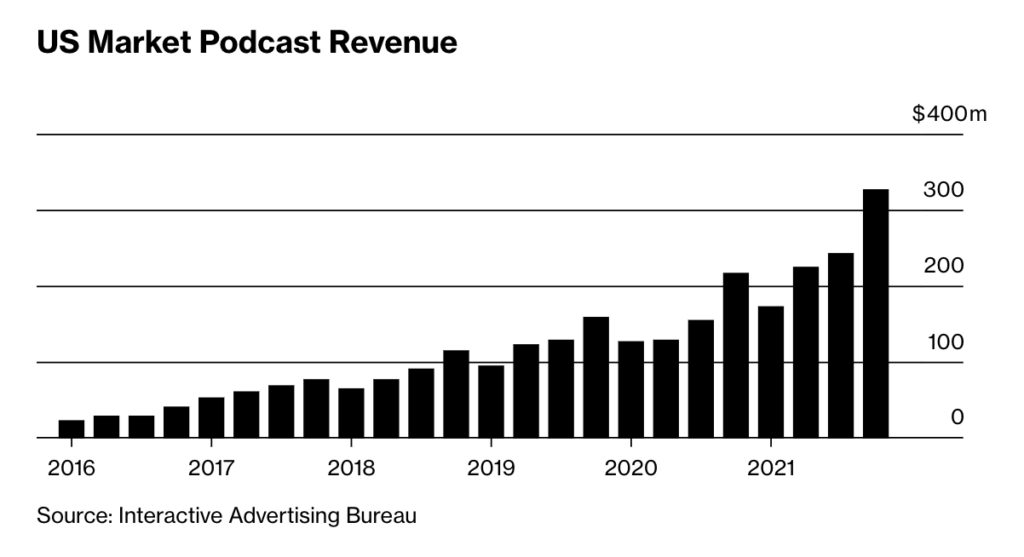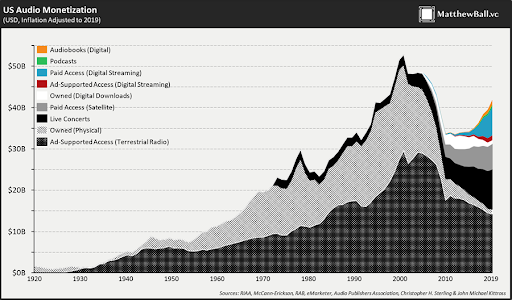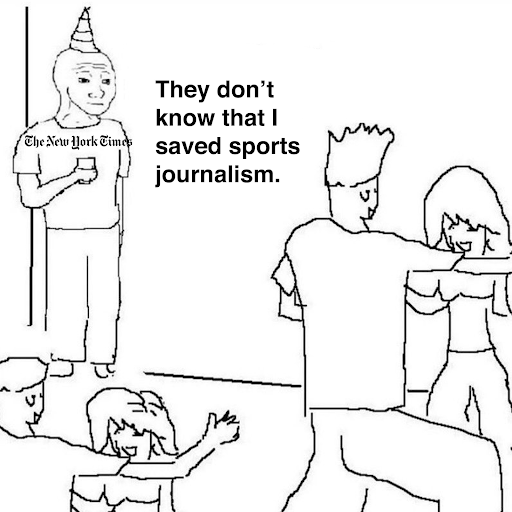30 June 2022 | Media
The Audio Opportunity in Front of Our Face
By Adam Ryan
Partnered With: #Paid
Welcome to the 279 media operators who have joined Perpetual since the last send. The open rate for the last newsletter was 46.4% UOR and UCTR was 3.5%.
The highest clicked links were my favorite book from my 20s, this article about how Taboola is evil, and the book we use to run Workweek.
For the last couple of weeks I’ve been testing a new format for my podcast. They are only 5 minute episodes. If you don’t mind, give it a listen and let me know what you think!
Let’s dive in.
Want to get these in your inbox to never miss an edition? Subscribe to Perpetual today!
SPONSORED BY #PAID
Influencer marketing isn’t dead. It’s different.
Long gone are the days of heavily edited pictures of glammed-up models laughing at their salads. Consumers want real content from real people, but finding these content wizards is easier said than done.
Enter #paid.
#paid helps DTC and Fortune 500 companies turn influencer marketing into a scalable media channel by matching brands with creators, to launch authentic, relevant, and measurable content campaigns across all marketing channels. And damn, are they good at it.
If you want to learn about how #paid has helped companies like Visa and UberEats level up their influencer marketing game, sign up for a walkthrough today.
The opportunity with audio
Bloomberg put out a hell of a piece on Spotify and audio. It was one of the most in-depth pieces I’ve read about the audio space.
Here is the TLDR:
- Spotify pivoted to podcasting 3 years ago because music comes with bad margins due to royalties. If they can own podcasts, the margins are expansive.
- They’ve built a multi-billion dollar subscription business, without turning a profit. Their stock is now down more than 70% since all time highs
- They’ve invested heavily in big names like Joe Rogan and Call Her Daddy. They hoped Rogan would be the “House of Cards” moment Netflix had. An internal report says it didn’t happen.
- Folks like Rogan have said things on their podcast that Spotify CEO has said he disagrees with. They’ve asked Rogan to not publish a few controversial episodes. He did it anyway. Their relationships with talent/creators is straining.
- Only 14% of podcasts on the platform currently earn the company money. They could potentially add a $100B in sales by going deeper into advertising.

Even though podcast growth is consistently going up, it hasn’t had explosive growth. What’s holding it back?
One huge issue: growth.
Anyone that dabbles in podcasts knows it’s one of the hardest mediums to grow. It’s at this odd point where it can serve as a top of funnel with mass reach (think Rogan and him selling protein powder), yet the best way to grow a podcast is by promoting it to a current audience via bottom of the funnel (think using large newsletter audiences to grow a podcast).
It causes podcast hosts and operators to be stuck in a rock and a hard place.
As of today, there are no great paid advertising opportunities with podcasts. Why? Because there’s no good data to show ROI of advertising spend.
It’s nearly impossible to have data on a user level on who listens to your podcast, which makes it incredibly difficult to build out a paid growth strategy.
Want to know why newsletters grew so much? Because consumers liked the format AND companies could easily measure return of ad spend .
The issue is that platforms like Spotify are the only ones with access to this data on a 1st party level.
How does this get solved?
For those who have read this newsletter every week, you may be surprised by this answer: Substack.
Yes, I hate on Substack a lot. Yes, they laid off 14% of their staff this week.
With that, they have created a closed loop system where their podcasting platform could be the most successful part of their entire business.
Imagine this as a media business: Your ESP is now a ASP (made this term up, but let’s call it an Audio Service Platform). It allows 1st party data to be collected by the media company/production studio on who is listening to the podcasts, how long, and, most importantly, how they discovered the podcast.
Can Spotify do this? Maybe, but their north star needs to change from building the Netflix of Audio to building the Facebook of Audio.
If they do that, they can keep their subscription because people will always pay for music, while building an ad network with enough data that allows marketers to not only grow their own podcasts but other products/services. Similar to YouTube, this strategy would allow Spotify to pay creators a cut – which will then increase the amount of content created in the audio format.
A move like this would increase the total addressable market for audio by 10 fold and Spotify would become a $250B+ company (at $18B today).
The impact this would have on media companies would be profound. They could start to diversify their revenue and start to own the ears of their audience, like media companies in the 1960s and 1970s did so well.

Daniel Elk, the CEO of Spotify, is all about creating a company that can have a huge impact on the world.
Well, Daniel, now you know how to do it
Digital Media: NYT & The Athletic
By: Alan Soclof
NYT
The New York Times has achieved something that most digital media companies do not: create a sustainable and profitable business.
Vice Media was once valued at $5.7B in 2017, but after failing to go public via SPAC in 2021 at a $3B valuation, the company is now looking for a sale at a price “significantly lower than” that.
Buzzfeed, who went public via SPAC in late 2021, has seen their equity value cut by more than 80% since IPO and, has lost money in six out of the last seven quarters.
Complex, the digital media company that Buzzfeed acquired for $300M in 2021, also has lost money in six out of the last seven quarters.
Buzzfeed and Complex are not new startups, but established media companies which have been around since 2006 and 2002, respectively – and they are not making money.
With this in mind, the New York Times’ successful and profitable pivot into the digital space is even more impressive.
The Times has grown digital news revenue from $223M to $694M (~3x) from 2015 to 2021, and digital revenue overtook the print-based revenue stream as its largest revenue segment in 2020.
Additionally, the company has maintained significant profitability while seeing this record growth in digital revenue, exemplified by a net income of $219M in 2021 vs. $100M in 2020 and $140M in 2019.
The Athletic
Today, I want to focus on the opportunities that the Times created for themselves, and how they used their cash flow to become an incubator of sorts for The Athletic — and why this is a sign of things to come.
The Athletic was launched in 2016 with the goal of providing sports fans high quality articles on their favorite sports teams and, in the process, replacing the dying local newspaper industry.
Five years later, the company has grown from a Y Combinator 2016 cohort member to a company that was acquired for $500M by the Times in January of 2022 with 1.2M paid subscribers.
With the acquisition, the Athletic will look to expand overseas and will also be included in the New York Times digital bundle.
Here are some other key stats surrounding the company at the time of the acquisition:
- 600 total employees, 400 of whom are in the newsroom
- $65M in 2021 revenue with a $55M operating loss
- Raised $140M in total in private markets with highest valuation @ $450M
- Expected to lose money for next 3 years before being profitable
Takeaways
In my eyes, the Athletic is incredibly lucky. The Times paid a significant price for the asset @ 7.5x sales, a multiple that we have not seen in the digital media space ever.
For example, In January of 2020, Barstool Sports sold @ a $430M valuation (36% initially). The company did between $90M-$100M in revenue in 2019 & $150M in revenue in 2020. This represents a 4.3x multiple of trailing sales & less than 3x forward – significantly less than The Athletic.
Barstool also was on the brink of profitability & has significant exposure to the rapidly growing sports gambling space while The Athletic did not. It is odd to me that Barstool was not acquired at a greater multiple than The Athletic.
There is the old adage that “Something is worth what someone is willing to pay for it.”
In many ways, the Times is the perfect partner for The Athletic due to their strong push into digital subscriptions as well as the need/opportunity to expand their sports offering.
Additionally, due to the Times’ strong cash flows, they can afford to fuel Athletic’s next three years of losses before reaching profitability. If the Times wasn’t there for The Athletic, I think the sports journalism company’s fortunes would have looked very different.
I do not expect this to be the last major move for the Times in the acquisitions market over the next couple of years. I would not be surprised if they scooped up a couple of Vice’s assets if bankers decide to sell the company off in pieces.
In a Meme

Jobs
Here are some jobs that I’m curating for the media industry. If you’re looking to hire, use this link to submit your role to be featured.
Email Strategy Freelancer @ Conde Nast
Conde Nast is looking for a Email Strategy Freelancer who is responsible for assisting the corporate email strategy & roadmap for multiple brands within the Conde Nast portfolio.
Executive Editor @ Insider, Inc
Insider is looking for a visionary Executive Editor to lead the more than 100 journalists across our bureaus all across the world.
CEO @ a Political Newsletter
This political newsletter has already launched and has subscribers. We are looking for an out of the box thinker who is passionate about what’s possible for a political media company. If you are looking for a new challenge leading vision on product, growth, and marketing and engineering scalable digital subscriber and revenue strategy is one of your superpowers then let’s connect!
Click here to view more jobs
Other stuff I like
- Simon Owen’s has been making some great content for the media industry. Give him a follow.
- This thread on the impact of Roe vs Wade on the Fintech industry. It was really insightful on how it impacts women in the workforce.
- I don’t like this at all, but it’s crazy to see how crypto has been getting crushed. BlockFi was valued at $3B last year and just sold for $25M. Yikes.
- Content to commerce is something we all talk about. If it’s something you want to go deeper in, email me and let me know!
Thanks for the read! Let me know what you thought by replying back to this email.
— Adam